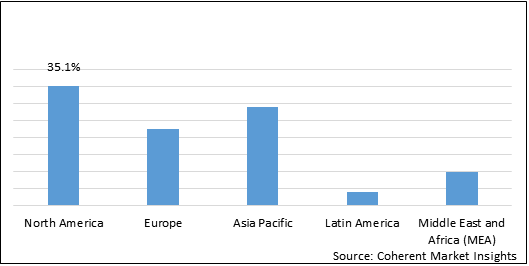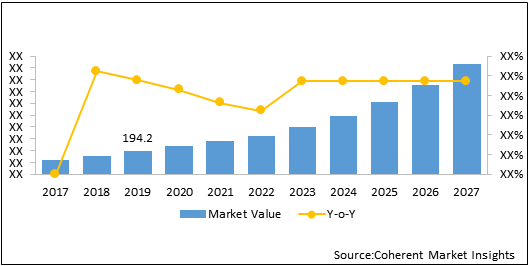
An application programming interface (API) is a computing interface that defines the interaction between numbers of software intermediaries. Telecom API helps developers create compatible applications for multiple devices under a particular network. A telecom carrier typically provides APIs geared toward SMS, MMS, location, voice, and payment, allowing the developer to integrate the required API in its application. The telecom carrier can charge the developer based on the number of APIs used in the application. Telecom API improves the scalability and flexibility of an application by managing the growing number of consumers in a network.
The global Telecom API Market was accounted for US$ 194.2 Bn in terms of value in 2019 and is expected to grow at CAGR of 23.6% for the period 2020-2027.
Market Dynamics- Drivers
Rising adoption of mobile internet and cloud technologies is expected to boost the use of the mobile application in the near future. According to the Cisco Visual Networking Index 2014 - 2019 report, the monthly global mobile data traffic is expected to rise at a CAGR of around 57% from 2014 to 2019 and is expected to surpass 24.3 Exabytes by 2019. Furthermore, according to the Groupe Speciale Mobile Association (GSMA) Mobile Economy Report 2015, the number of people using mobile Internet is expected to reach 3.8 billion by 2020. Rapid growth of mobile cloud is expected to accelerate adoption of telecom API for data and video storage in telecom-owned cloud systems. Hence, these factors are expected to drive growth of the global telecom API market during the forecast period.
According to GSMA Intelligence, 352 telecom carriers had launched 4G LTE (Long-Term Evolution) networks across 124 countries until January 2015. 4G LTE offers high-bandwidth internet connectivity for uninterrupted audio and video streaming. Furthermore, 4G LTE provides voice over LTE (VoLTE) based on IP multimedia systems thereby allowing high-clarity voice. 4G LTE eliminates the need for separate networks for voice and data for a given telecom tower. VoLTE can be deployed with RCS and video calls over LTE, facilitating MMS, chat, file sharing, and video transfer. Thus, these factors are expected to propel the global telecom API market growth over the forecast period.
Statistics:
North America held dominant position in the global Telecom API market in 2019, accounting for 35.1% share in terms of value, followed by Asia Pacific and Europe respectively
Figure 1: Global Telecom API Market Share (%) in terms of Value, By Region, 2019

To learn more about this report, Download Free Sample
Impact of COVID-19:
The telecom API are used to create compatible applications for multiple devices under a particular network. The telecom API’s offers Customer Service Point (CSPs) to integrate features such as Real-time Communications, Messaging, Payment options and many more. There are several countries such as India and Spain who have imposed lockdown due to the COVID-19 pandemic. Owing to this, companies are conducting meetings on online platforms and also increased spending on IT infrastructure due to government rules and regulations. For instance, In July 2020, Department of Communications of India ordered IT companies to extend work from home for their employees till 31st December 2020. The increasing spending on IT infrastructure is expected to drive the growth of the given market during the forecast period 2020-2027.
Market Dynamics- Restraints
Over the top service refers to services such as audio, video, and other data through the internet independent of telecom carriers. Telecom carriers incur infrastructure costs and can only charge for the amount of data is used by end users. On the contrary, OTT service providers can generate additional revenues depending upon the service provided. Introduction of VoIP is decreasing the demand for voice-based services provided by telecom carriers. The amount of revenue generated from telecom carrier services such as SMS, MMS, and voice services is declining, owing to the presence of OTT services. According to GSMA Intelligence, the use of traditional SMS in order to communicate between person-to-person (P2P) has dropped by double-digit percentages quarter-over-quarter between 2010 and 2011. Hence, these factors are expected to restrain growth of the market during the forecast period.
A large number of telecom carriers are increasing including telecom API services in their portfolio. However, very few telecom carriers such as AT&T, Inc. and Orange S.A. are opening up their telecom API platform to external developers. Most telecom carriers consider application developers as value-added resellers and provide a business model that exposes less of the API platform to the developer. This restricts the possibilities for innovation in telecom API platforms and developers are not able to create applications using telecom API. Opening the telecom API platform to developers is expected to generate revenue by creating more applications. Hence, these factors are expected to hamper the global telecom API market growth over the forecast period.
Telecom API Market Report Coverage
| Report Coverage | Details | ||
|---|---|---|---|
| Base Year: | 2019 | Market Size in 2019: | USD 194.2 Bn |
| Historical Data for: | 2016 to 2019 | Forecast Period: | 2020 to 2027 |
| Forecast Period 2020 to 2027 CAGR: | 23.6% | 2027 Value Projection: | USD 933.0 Bn |
| Geographies covered: |
|
||
| Segments covered: |
|
||
| Companies covered: |
AT&T, Inc., Comverse, Inc., Apigee Corp., Nexmo, Inc., LocationSmart, Fortumo OU, Alcatel-Lucent, Aepona Ltd., Orange S.A., Tropo, Inc., Twilio, Inc., and Huawei |
||
| Growth Drivers: |
|
||
| Restraints & Challenges: |
|
||
Uncover macros and micros vetted on 75+ parameters: Get instant access to report
Market Opportunities
The connectivity of M2M devices with smartphones is expected to increase in coming years and is expected to further increase the demand for telecom network APIs. According to the Cisco Visual Networking Index 2014 - 2019 report, the number of M2M connections is expected to reach 3.2 billion by 2019 and is expected to rise at a CAGR of 45% from 2014 to 2019. Telecom carrier companies such as Orange S.A. and AT&T, Inc. have started offering M2M platforms to integrate mobile devices with M2M-connected devices. According to the GSMA Mobile Economy Report 2015, the total number of mobile M2M connections are expected to grow at a CAGR of 26% between 2014 and 2020. M2M devices include wearable watches equipped with sensors, smart homes, and home security systems. These devices are able to connect with smartphones and share information. Smartphones utilize this collected data and convert it into meaningful information for the end-user.
Key players operating in the market are focused on research and development activities, in order to enhance the product portfolio. For instance, in September 2013, AT&T Inc. launched an enterprise-focused API program that allows enterprise customers to innovate using AT&T network APIs. Furthermore, in November 2015, Apigee Corp. introduced Apigee Identity APIx, an API-based solution that empowers mobile network operators to deliver and manage security services.
Figure 2: Global Telecom API Market Value (US$ Bn), 2017 - 2027

To learn more about this report, Download Free Sample
The global Telecom API market was valued at US$ 194.2 Bn in 2019 and is forecast to reach a value of US$ 933.0 Bn by 2027 at a CAGR of 23.6% between 2020 and 2027.
Market Trends
North America comprises majority of telecom API service providers when compared to the other regions across the world. New enhancements related to telecom API are primarily introduced in the U.S. and then marketed around the world. According to GSMA Intelligence, the 4G LTE coverage reached 97% of the population in North America by 2013. The penetration of 4G connections in North America is expected to reach 80% of the total connections by the end of 2020. 4G LTE enables high-speed Internet bandwidth connectivity to the end user. Moreover, with the introduction of 4G LTE, telecom carriers are also expected to provide VoLTE service to the end-users in the coming years. According to the Cisco Visual Networking Index, the mobile data traffic is expected to reach 3.8 Exabytes/month by 2019 at a CAGR of 47% from 2014 to 2019.
According to the Ericsson Mobility Report Europe 2014, the smartphone subscription is expected to reach 765 Bn by 2019. According to GSMA Intelligence, the unique subscriber penetration in Europe is expected to reach 79%, growing from 403 Bn in 2013 to 417 Bn in 2017. The adoption of the 4G LTE network in Europe has been slow compared to North America. However, the 4G LTE network segment in the region is expected to grow significantly during the next few years. According to GSMA Intelligence, the market for 4G LTE enabled SIM connections in Europe is expected to reach up to 152 Bn by 2017 from 25 Bn in 2014. These factors are expected to lead to a rise in the Internet user base and the adoption of VoLTE among the European population. This, in turn, is expected to drive the market for voice API during the coming years.
Competitive Section
Key players operating in the global telecom API market are AT&T, Inc., Comverse, Inc., Apigee Corp., Nexmo, Inc., LocationSmart, Fortumo OU, Alcatel-Lucent, Aepona Ltd., Orange S.A., Tropo, Inc., Twilio, Inc., and Huawei
Key Developments
Major companies are focused on product launches, in order to expand the product portfolio. For instance, in October 2018, Nexmo, Inc., a subsidiary of Vonage Hldgs, introduced a next-generation messaging solution around two new APIs namely Dispatch API and Messages API.
Share
Share
Missing comfort of reading report in your local language? Find your preferred language :
Transform your Strategy with Exclusive Trending Reports :
Frequently Asked Questions
Select a License Type
Joining thousands of companies around the world committed to making the Excellent Business Solutions.
View All Our Clients